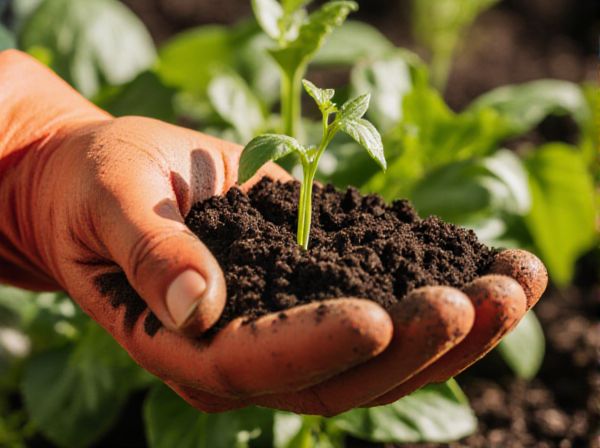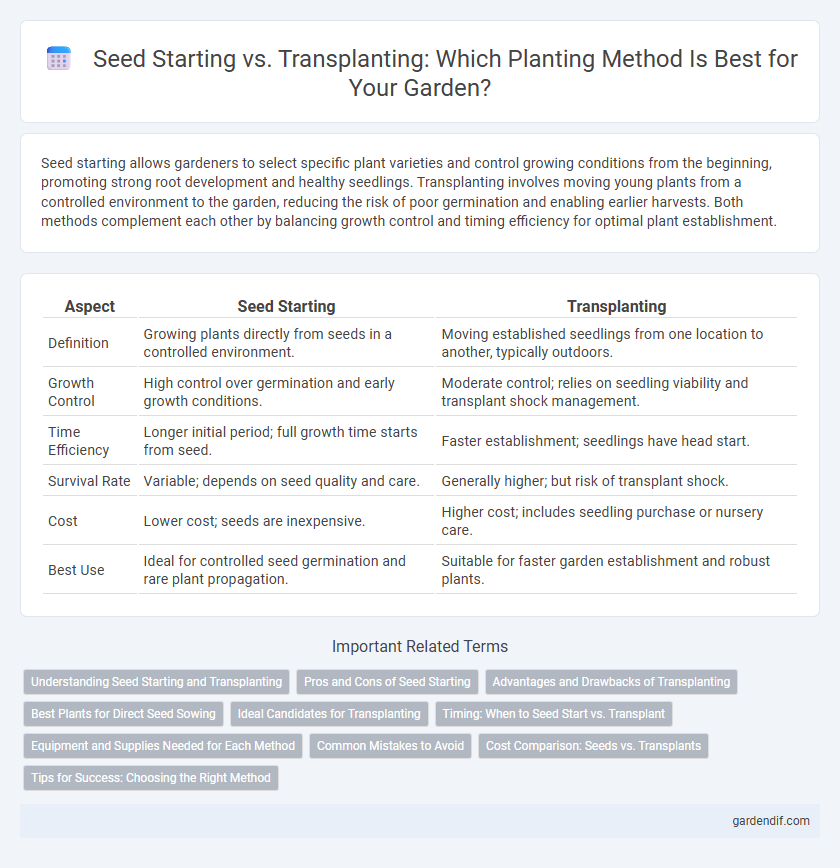
Seed Starting vs Transplanting Illustration
Seed starting allows gardeners to select specific plant varieties and control growing conditions from the beginning, promoting strong root development and healthy seedlings. Transplanting involves moving young plants from a controlled environment to the garden, reducing the risk of poor germination and enabling earlier harvests. Both methods complement each other by balancing growth control and timing efficiency for optimal plant establishment.
Table of Comparison
| Aspect | Seed Starting | Transplanting |
|---|---|---|
| Definition | Growing plants directly from seeds in a controlled environment. | Moving established seedlings from one location to another, typically outdoors. |
| Growth Control | High control over germination and early growth conditions. | Moderate control; relies on seedling viability and transplant shock management. |
| Time Efficiency | Longer initial period; full growth time starts from seed. | Faster establishment; seedlings have head start. |
| Survival Rate | Variable; depends on seed quality and care. | Generally higher; but risk of transplant shock. |
| Cost | Lower cost; seeds are inexpensive. | Higher cost; includes seedling purchase or nursery care. |
| Best Use | Ideal for controlled seed germination and rare plant propagation. | Suitable for faster garden establishment and robust plants. |
Understanding Seed Starting and Transplanting
Seed starting involves germinating seeds in a controlled environment to ensure optimal growth conditions, improving seedling survival rates. Transplanting moves these young plants from seed trays or greenhouses into the garden or larger containers, reducing the risk of shock by acclimating them gradually. Understanding the timing, soil preparation, and moisture management during both processes is crucial for successful plant establishment.
Pros and Cons of Seed Starting
Seed starting allows growers to select plant varieties with precision and control growing conditions, leading to stronger and healthier seedlings. It is cost-effective and enables early planting indoors, extending the growing season, but requires more time, attention, and specialized equipment like trays and grow lights. Risks include issues with germination rates and seedling diseases, which can delay or hinder plant development compared to transplanting established plants.
Advantages and Drawbacks of Transplanting
Transplanting allows plants to establish in controlled environments before being moved outdoors, ensuring stronger seedlings and reducing the risk of poor germination. However, it can cause transplant shock, slowing growth temporarily and increasing susceptibility to diseases if roots are disturbed. While transplanting saves space and extends the growing season, it demands more labor and careful handling compared to direct seed starting.
Best Plants for Direct Seed Sowing
For direct seed sowing, fast-growing plants like beans, carrots, radishes, and peas thrive best when planted directly in the soil, benefiting from minimal root disturbance and natural growth cycles. Hardy vegetables such as corn, spinach, and beets also perform well when sown straight into garden beds, ensuring stronger root systems and better adaptation to outdoor conditions. Choosing crops suited for direct sowing reduces the risk of transplant shock and accelerates growth efficiency in garden environments.
Ideal Candidates for Transplanting
Hardy plants such as tomatoes, peppers, and brassicas are ideal candidates for transplanting because they can withstand the shock of being moved and establish quickly in the garden. Seedlings started indoors benefit from controlled environments that promote strong root development before being hardened off for outdoor conditions. Perennials and larger vegetable crops also respond well to transplanting, which allows for an extended growing season and improved early growth vigor.
Timing: When to Seed Start vs. Transplant
Seed starting should be done indoors 6-8 weeks before the last expected frost to ensure seedlings are strong enough for outdoor conditions. Transplanting typically occurs after the danger of frost has passed and soil temperatures reach at least 60degF, promoting healthy root establishment. Timely coordination between seed starting and transplanting maximizes plant survival and growth.
Equipment and Supplies Needed for Each Method
Seed starting requires essentials such as seed trays, quality seed-starting mix, heat mats for temperature control, grow lights to ensure adequate light exposure, and humidity domes to maintain moisture levels. Transplanting involves sturdy containers or pots, high-quality potting soil enriched with nutrients, root stimulators to minimize shock, and appropriate tools like trowels or dibbers for moving seedlings safely. Both methods benefit from labels, watering cans with fine nozzles, and a well-ventilated environment to support healthy plant development.
Common Mistakes to Avoid
Starting seeds indoors often leads to overwatering, which causes root rot and weak seedlings. Transplanting too late can result in transplant shock, stunting plant growth and reducing yields. Avoid planting seeds too deeply, as insufficient light and poor aeration hinder germination and seedling development.
Cost Comparison: Seeds vs. Transplants
Starting plants from seeds typically costs significantly less than buying established transplants, with seed packets often priced below $5 compared to $3-$10 per individual transplant. While seeds require more time, supplies, and care, the overall investment is lower, making seed starting ideal for budget-conscious gardeners. Transplants offer convenience and faster plant maturity but come at a higher upfront expense, impacting the total gardening budget.
Tips for Success: Choosing the Right Method
Selecting the ideal seed starting or transplanting method hinges on plant species, climate, and available space to enhance growth efficiency. Seed starting offers control over germination conditions, ensuring strong root development, while transplanting mature seedlings reduces vulnerability to pests and adverse weather. Employing high-quality soil, maintaining optimal moisture, and gradually acclimating plants to outdoor environments maximizes success rates in both methods.
Seed Starting vs Transplanting Infographic

 gardendif.com
gardendif.com